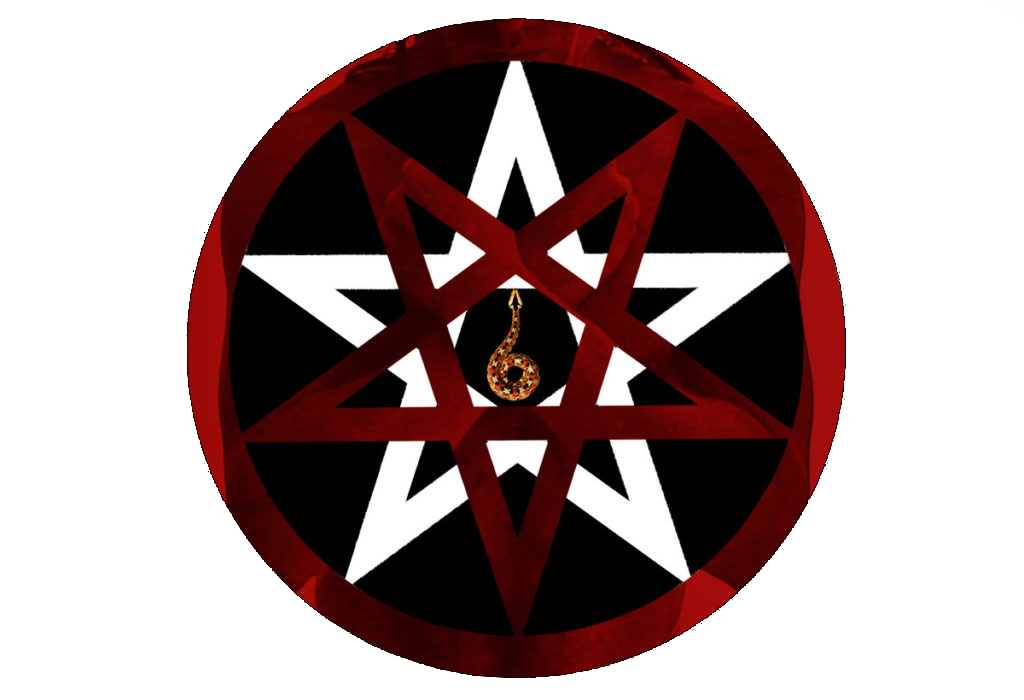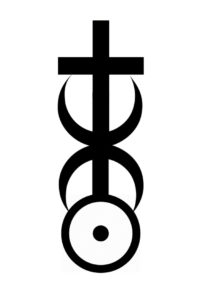
The Left-hand Path in our understanding is the way of transgressing and transcending the limits of internalised societal structures and inauthentic beliefs. Or put another way, all that is not of our core self or experience. The path has a focus on the female and epicene sexual current and sexual magick as the most potent avenue to Liberation or full core or authentic awareness and empowerment.
The term, Left-hand Path (LHP) derives most clearly from Hindu practices, Vāmāchāra (Left-handed Attainment or Conduct) or Vāmamārga (Left-hand Path). The word Vāmā refers to the Left as well as both Shiva (male current) and Shakti (female current). The main group associated with the term are the Hindu ascetics known as the Aghori. The concept is well established and elements can be seen in many Sadhana (Tantric ritual practices) as well as in other aspects of Hinduism, Buddhism and Jainism.
The term most likely derives in Western culture from the work of Ukrainian Theosophist Helena Blavatsky, who was trying to bring Eastern and Western ideas together, unfortunately laced with plenty of racism and dishonesty.
Blavatsky seems to have misunderstood the essential concept of Vāmamārga and looked at it in much the same terms as the binary of good and evil as understood within Christianity and other Middle Eastern cults – a concept that would be quite alien to the Monist philosophy of the Aghori.
Part of the importance of breaking taboos for the Aghori is the realisation that all is one, or non-dual, then there can be no notion of a taboo or unholy action.
The LHP can also be seen reflected in Qabalah (although in a Dualist sense), with the left or black pillar ending in the sephiroth of Binah (understanding), often associated with female sexuality and many ideas similar to those of the Shakti current, which is central to the Tantric understanding of the Vāmamārga.
However, although the term ‘Left-hand path’ does have its roots in India, it is clear that LHP ideas arise naturally almost everywhere as an understanding of the spiritual power of breaking the inner patterns of established thinking and actions. The term is most useful as an umbrella term for such ideas, but should really be seen as outside of any specific culture. In the same sense that the word ‘magick’ may have its origin in the Zoroastrian priesthood, the Magi, magick cannot be said to only exist or always to stem from that culture.
The LHP is discernible wherever it is expressed because it includes common themes. For example, a reverence for the female current, sexuality, the physical world, and ‘opposite doing’ or the breaking of taboo. The opposite doing focus of the LHP is why it has become confused with many of the adolescent ideas of American Satanism and other similar concepts. But it is really a deep process of self-reflection and the stripping away of ingrained limitations.
Within English and European culture it is clear Aleister Crowley did give a lot to the notion of the Left-hand path in principle. While his general definition of the LHP referred to the idea of not crossing the Abyss (Da’at) on the Tree of Life within Qabalah, his actual practices often reflect LHP and opposite doing. So if we look at Crowley through the lens of the meaning of the LHP, rather than how he used the term, it is clear he was practicing the transgressive path. This is only underlined more by his focus on the Goddess Babalon. Babalon clearly encapsulates the sexual current, as does Crowley’s approach to sexual magick in general. It is clear Crowley was also one of the first to introduce Sadistic and BDSM elements, as well as coprophilia and other fetishes into sexual magick.
Another Englishman of great importance, especially to the idea of LHP Witchcraft is Austin Osman Spare. In his works, The Book of Ugly Ecstasy and The Book of Pleasure the practices of the breaking of taboo and transforming revulsion into desire and sexual magick are clear. His concept of ‘Self-Love’ is a key practice for many sexual magickians, and he clearly had a transgender and transgressive understanding within his work. The idea of the epicene, transgender, and non-binary are key to my understanding of the LHP. It goes back to the roots of what I see as an expression of this current or archetype in European culture.
In early Scandinavian culture the concepts of a LHP in all but name can be seen in the transformative journey of Wóden or Óðinn. During the Viking age certain actions and practices associated with women were deemed to be taboo or ergi for men. The term ergi literally meant unmanly, lustful and wicked. This idea was especially associated with the practice of Seiðr, or a form of shamanism or witchcraft with a focus on seething trance, sexuality, and the feminine. It was taboo or ergi for a man to practice Seiðr, yet Óðinn, the principle God in the Nordic pantheon is described as learning the art.
I feel that this reveals a deeper aspect to the story of Óðinn/Wóden. He was the most powerful and wise precisely because he was able to transgress the ideas of mainstream Viking society and open to the epicene and ‘opposite doing’ current. Óðinn was a master of both Galdr (invocation) and Seiðr (witchcraft/sorcery), showing his complete spiritual empowerment.
English Witchcraft too has long held many elements of the transgressive current. It has long been noted that the sexuality and femininity within Witchcraft has caused the powers of religion and the monarchy to fear the power in these Sabbatic practitioners.
Sexual power is at the heart of why even in modern history the state have feared sexual magickians. Aleister Crowley was expelled from Sicily by Mussolini, Jack Parsons was investigated by the CIA, in the nineteen-eighties and nineties many lost their jobs across the UK out of fear of Witchcraft and sexual abandon.
In my own practice I draw upon my direct experience from trance states. My connections with Wóden and Seiðr, the masochistic archetype Zulsa and sexual nature of Dayanu. These in turn activated by Shaa, the reptilian current of sexual, sadistic and creative energy. I will explore these topics in individual articles.
So in conclusion, where I feel we have reached now, in the modern age, is the realisation within the consciousness of society, many of the elements of the LHP current.
I will end as I began, by saying, the Left-hand Path in my understanding is the way of transgressing and transcending the limits of what many of us have learnt to believe we are. Where that is leading is towards the wider world and society beginning to awaken to the taboo current of sexual sadomasochist exploration of liberation.

